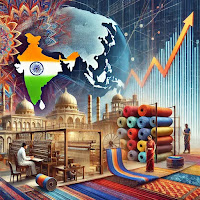India's Textile Sector: Weaving a Future of Growth and Global Influence...
A Robust Domestic Foundation:
India’s rapidly growing middle class and rising disposable incomes are fueling unprecedented domestic demand for textiles and apparel. With per capita income projected to reach ₹3.5 lakh by 2030, the domestic market is thriving. This growth is further bolstered by several key factors:
- Digital Empowerment: The widespread adoption of digital technologies, including e-commerce platforms and UPI payments, is revolutionizing the industry. These advancements are bridging the urban-rural divide, empowering artisans, and connecting them directly with consumers.
- Government-Led Initiatives: Programs like Atmanirbhar Bharat and the Production-Linked Incentive (PLI) scheme are driving domestic manufacturing, attracting investments, and creating millions of jobs. The establishment of PM MITRA textile parks is also enhancing efficiency by creating integrated textile hubs.
- Evolving Consumer Preferences: A shift in consumer mindset toward quality, style, and convenience is driving demand for premium products, including handcrafted textiles, designer wear, and sustainable fashion.
- Strong Domestic Consumption: Private consumption has surged from ₹87 lakh crore in 2013 to ₹183 lakh crore in 2024, underscoring the strength of India’s internal market.
Global Expansion and Value-Added Exports:
India’s textile exports are gaining momentum, despite stiff global competition. The sector is increasingly focusing on value-added products, which are enhancing its appeal in international markets. Key developments include:
- Export Growth: Textile and apparel exports grew by 7.19% in the first eleven months of FY 2024-25, reaching $33.217 billion. Apparel exports, in particular, saw a strong 10.71% increase.
- Diversification and Specialization: India is making strides in specialized segments such as technical textiles, carpets, and handcrafted fabrics. For instance, carpet exports surged by 12.52% to $1,403.97 million.
- Heritage and Luxury Revival: Traditional Indian textiles like Banarasi silks and Kanjeevarams are experiencing a resurgence, creating new export opportunities. Additionally, the booming Indian wedding industry is driving demand for high-quality, luxurious textiles.
- Increased Market Share: The share of textiles and apparel in India’s total merchandise exports rose to 8.40% during April 2024–February 2025, reflecting the sector’s growing global influence.
Strategic Advantages and Future Potential:
India’s textile sector is uniquely positioned for sustained growth, thanks to several strategic advantages:
- Abundant Raw Materials: As a leading producer of cotton and man-made fibers, India boasts a strong raw material base, ensuring a steady supply for domestic and export markets.
- Skilled Workforce: The industry employs millions of skilled artisans and workers, giving India a competitive edge in labor-intensive manufacturing.
- Sustainability Focus: India is increasingly adopting sustainable practices, aligning with global trends and consumer preferences for eco-friendly products.
- Free Trade Agreements (FTAs): Ongoing negotiations with key markets like the EU and UK hold immense potential to boost exports and expand India’s global footprint.
Addressing Challenges for Continued Growth:
While the sector’s future is bright, addressing certain challenges is critical to unlocking its full potential:
- Enhancing Competitiveness: Streamlining supply chains, reducing logistical costs, and improving productivity are essential to compete with global rivals like China and Vietnam.
- Investing in Technology: Modernizing manufacturing processes and adopting advanced technologies, such as automation and AI, can significantly improve efficiency and product quality.
- Infrastructure Development: Investments in transportation, logistics, and port facilities are needed to facilitate smoother trade and reduce delays.
- Simplifying Regulations: Streamlining customs procedures and reducing bureaucratic hurdles will enhance the ease of doing business and attract more foreign investment.
Conclusion:
By leveraging its strengths, addressing challenges, and fostering a culture of innovation and sustainability, India’s textile sector is on track to become a global leader. With a strong domestic foundation, a growing export market, and strategic advantages, the industry is weaving a future of growth, prosperity, and global influence.

No comments:
Post a Comment